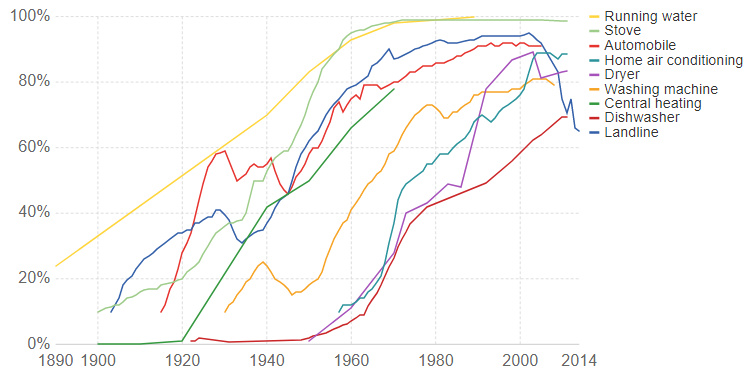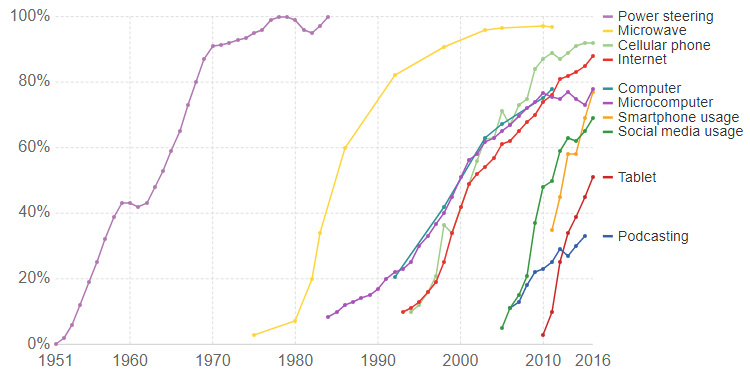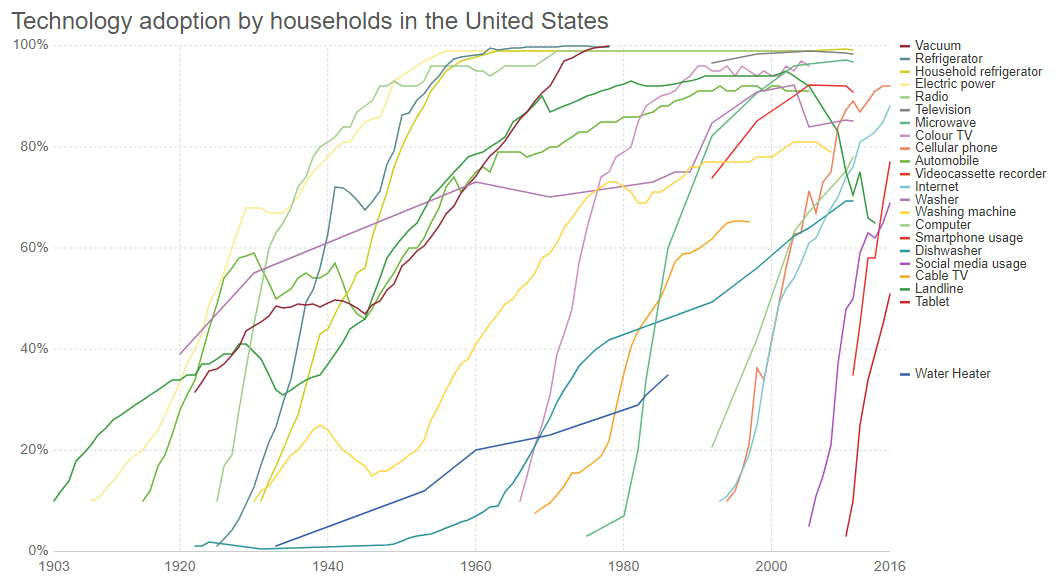Technology
The Rising Speed of Technological Adoption
The Rising Speed of Technological Adoption
Technological progress is not the only thing rising at an exponential rate.
The rate at which newly commercialized technologies get adopted by consumers is also getting faster, too.
In the modern world, through increased connectivity, instant communication, and established infrastructure systems, new ideas and products can spread at speeds never seen before – and this enables a new product to get in the hands of consumers in the blink of an eye.
Visualizing Technological Adoption
Today’s dynamic chart comes to us from Our World in Data, and it allows you to compare the adoption rates of new technologies over the period of more than a century.
In addition to the technologies you’ll find embedded on the initial chart above, you can also use the “Add technology” tab of the chart (bottom left) to list up to 40 tech data series on the chart in total. This allows you to gauge adoption rates for everything from color televisions to washing machines, while giving you an idea of the trajectory of many common technologies today.
A Blast From the Past
To get the full impact of the chart, it’s worth removing more modern technologies like smartphones, social media, tablets, cellular phones, and the internet from the list.
Here’s a look at adoption rates for the household appliances and products today that we would consider pretty essential, over a period of more than 120 years:

The telephone was invented in 1876, but it wasn’t until a century later that landlines reached a saturation point in households.
For this to happen, massive amounts of infrastructure had to be built and network effects also needed to accumulate to make the product worthwhile for consumers. Further, the telephone suffered from the “last-mile problem”, in which the logistics get tougher and more expensive as end-users get hooked up to a network.
As a result, it wasn’t until the 1960s that 80% of U.S. households had landlines in them.
New Adoption Speeds
Now, here’s a chart with many older technologies removed – keep in mind that the x axis has changed to a much shorter timespan (~65 years):

Microwaves, cell phones, smartphones, social media, tablets, and other inventions from the modern era all show fast-rising adoption rates. Standing out most on the chart is the tablet computer, which went from nearly 0% to 50% adoption in five years or so.
Why do newer technologies get adopted so quickly? It seems partly because modern tech needs less infrastructure in contrast with the water pipes, cable lines, electricity grids, and telephone wires that had to be installed throughout the 20th century.
However, it also says something else about today’s consumers – which is that they are connected, fast-acting, and not afraid to adopt the new technologies that can quickly impact their lives for the better.
Technology
Charting the Next Generation of Internet
In this graphic, Visual Capitalist has partnered with MSCI to explore the potential of satellite internet as the next generation of internet innovation.

Could Tomorrow’s Internet be Streamed from Space?
In 2023, 2.6 billion people could not access the internet. Today, companies worldwide are looking to innovative technology to ensure more people are online at the speed of today’s technology.
Could satellite internet provide the solution?
In collaboration with MSCI, we embarked on a journey to explore whether tomorrow’s internet could be streamed from space.
Satellite Internet’s Potential Customer Base
Millions of people live in rural communities or mobile homes, and many spend much of their lives at sea or have no fixed abode. So, they cannot access the internet simply because the technology is unavailable.
Satellite internet gives these communities access to the internet without requiring a fixed location. Consequently, the volume of people who could get online using satellite internet is significant:
| Area | Potential Subscribers |
|---|---|
| Households Without Internet Access | 600,000,000 |
| RVs | 11,000,000 |
| Recreational Boats | 8,500,000 |
| Ships | 100,000 |
| Commercial Aircraft | 25,000 |
Advances in Satellite Technology
Satellite internet is not a new concept. However, it has only recently been that roadblocks around cost and long turnaround times have been overcome.
NASA’s space shuttle, until it was retired in 2011, was the only reusable means of transporting crew and cargo into orbit. It cost over $1.5 billion and took an average of 252 days to launch and refurbish.
In stark contrast, SpaceX’s Falcon 9 can now launch objects into orbit and maintain them at a fraction of the time and cost, less than 1% of the space shuttle’s cost.
| Average Rocket Turnaround Time | Average Launch/Refurbishment Cost | |
|---|---|---|
| Falcon 9* | 21 days | < $1,000,000 |
| Space Shuttle | 252 days | $1,500,000,000 (approximately) |
Satellites are now deployed 300 miles in low Earth orbit (LEO) rather than 22,000 miles above Earth in Geostationary Orbit (GEO), previously the typical satellite deployment altitude.
What this means for the consumer is that satellite internet streamed from LEO has a latency of 40 ms, which is an optimal internet connection. Especially when compared to the 700 ms stream latency experienced with satellite internet streamed from GEO.
What Would it Take to Build a Satellite Internet?
SpaceX, the private company that operates Starlink, currently has 4,500 satellites. However, the company believes it will require 10 times this number to provide comprehensive satellite internet coverage.
Charting the number of active satellites reveals that, despite the increasing number of active satellites, many more must be launched to create a comprehensive satellite internet.
| Year | Number of Active Satellites |
|---|---|
| 2022 | 6,905 |
| 2021 | 4,800 |
| 2020 | 3,256 |
| 2019 | 2,272 |
| 2018 | 2,027 |
| 2017 | 1,778 |
| 2016 | 1,462 |
| 2015 | 1,364 |
| 2014 | 1,262 |
| 2013 | 1,187 |
Next-Generation Internet Innovation
Innovation is at the heart of the internet’s next generation, and the MSCI Next Generation Innovation Index exposes investors to companies that can take advantage of potentially disruptive technologies like satellite internet.
You can gain exposure to companies advancing access to the internet with four indexes:
- MSCI ACWI IMI Next Generation Internet Innovation Index
- MSCI World IMI Next Generation Internet Innovation 30 Index
- MSCI China All Shares IMI Next Generation Internet Innovation Index
- MSCI China A Onshore IMI Next Generation Internet Innovation Index
MSCI thematic indexes are objective, rules-based, and regularly updated to focus on specific emerging trends that could evolve.

Click here to explore the MSCI thematic indexes

-

 Technology2 weeks ago
Technology2 weeks agoCountries With the Highest Rates of Crypto Ownership
While the U.S. is a major market for cryptocurrencies, two countries surpass it in terms of their rates of crypto ownership.
-

 Technology2 weeks ago
Technology2 weeks agoMapped: The Number of AI Startups By Country
Over the past decade, thousands of AI startups have been funded worldwide. See which countries are leading the charge in this map graphic.
-

 Technology3 weeks ago
Technology3 weeks agoAll of the Grants Given by the U.S. CHIPS Act
Intel, TSMC, and more have received billions in subsidies from the U.S. CHIPS Act in 2024.
-

 Technology3 weeks ago
Technology3 weeks agoVisualizing AI Patents by Country
See which countries have been granted the most AI patents each year, from 2012 to 2022.
-

 Technology4 weeks ago
Technology4 weeks agoHow Tech Logos Have Evolved Over Time
From complete overhauls to more subtle tweaks, these tech logos have had quite a journey. Featuring: Google, Apple, and more.
-

 AI1 month ago
AI1 month agoRanked: Semiconductor Companies by Industry Revenue Share
Nvidia is coming for Intel’s crown. Samsung is losing ground. AI is transforming the space. We break down revenue for semiconductor companies.
-

 United States6 days ago
United States6 days agoMapped: Countries Where Recreational Cannabis is Legal
-

 Healthcare2 weeks ago
Healthcare2 weeks agoLife Expectancy by Region (1950-2050F)
-

 Markets2 weeks ago
Markets2 weeks agoThe Growth of a $1,000 Equity Investment, by Stock Market
-

 Markets2 weeks ago
Markets2 weeks agoMapped: Europe’s GDP Per Capita, by Country
-

 Money2 weeks ago
Money2 weeks agoCharted: What Frustrates Americans About the Tax System
-

 Technology2 weeks ago
Technology2 weeks agoCountries With the Highest Rates of Crypto Ownership
-

 Mining2 weeks ago
Mining2 weeks agoWhere the World’s Aluminum is Smelted, by Country
-

 Personal Finance1 week ago
Personal Finance1 week agoVisualizing the Tax Burden of Every U.S. State












